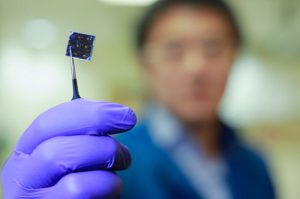Materials scientists from the UCLA Samueli School of Engineering have developed a powerful thin-film solar cell that generates more energy from sunlight than average solar panels, as a result of its double-layer design, according to UCLA.
The device is made of an inexpensive compound of lead and iodine, known as perovskite, that has proven to be very efficient at capturing energy from sunlight. A thin layer of the perovskite is sprayed onto a commercially available solar cell, while the solar cell that forms the bottom layer of the device is made of a compound of copper, indium, gallium and selenide, or CIGS, creating a new cell that successfully converts 22.4 percent of the incoming energy from the sun, versus the previous record of 10.9 percent by a group at IBM’s Thomas J. Watson Research Center in 2015.



